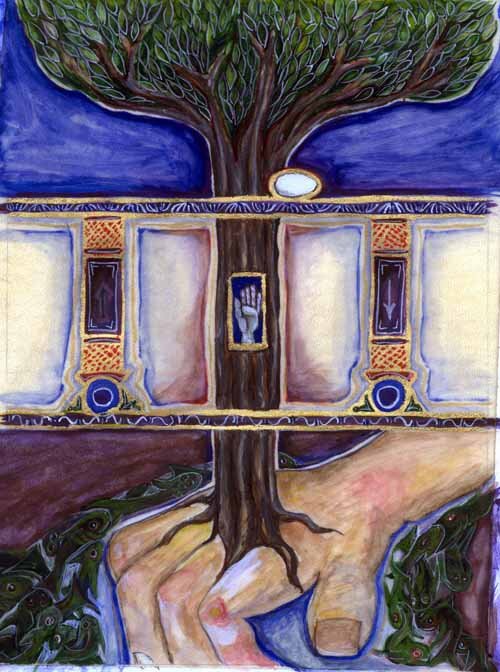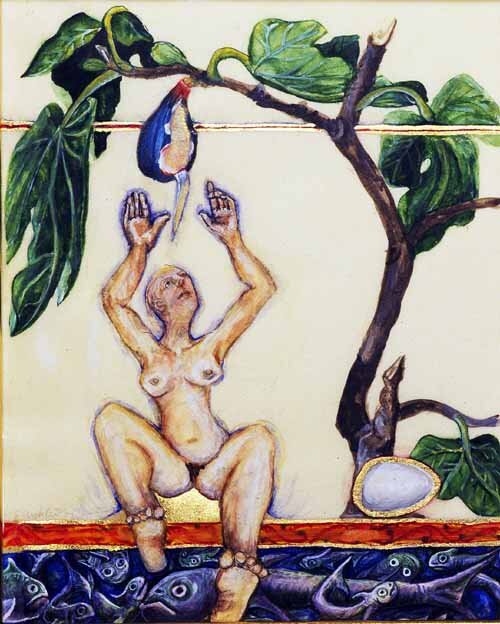Below is a new video interview about the meaning behind my work. I hope you enjoy it. Blessings, SybilLink for email subscribers.


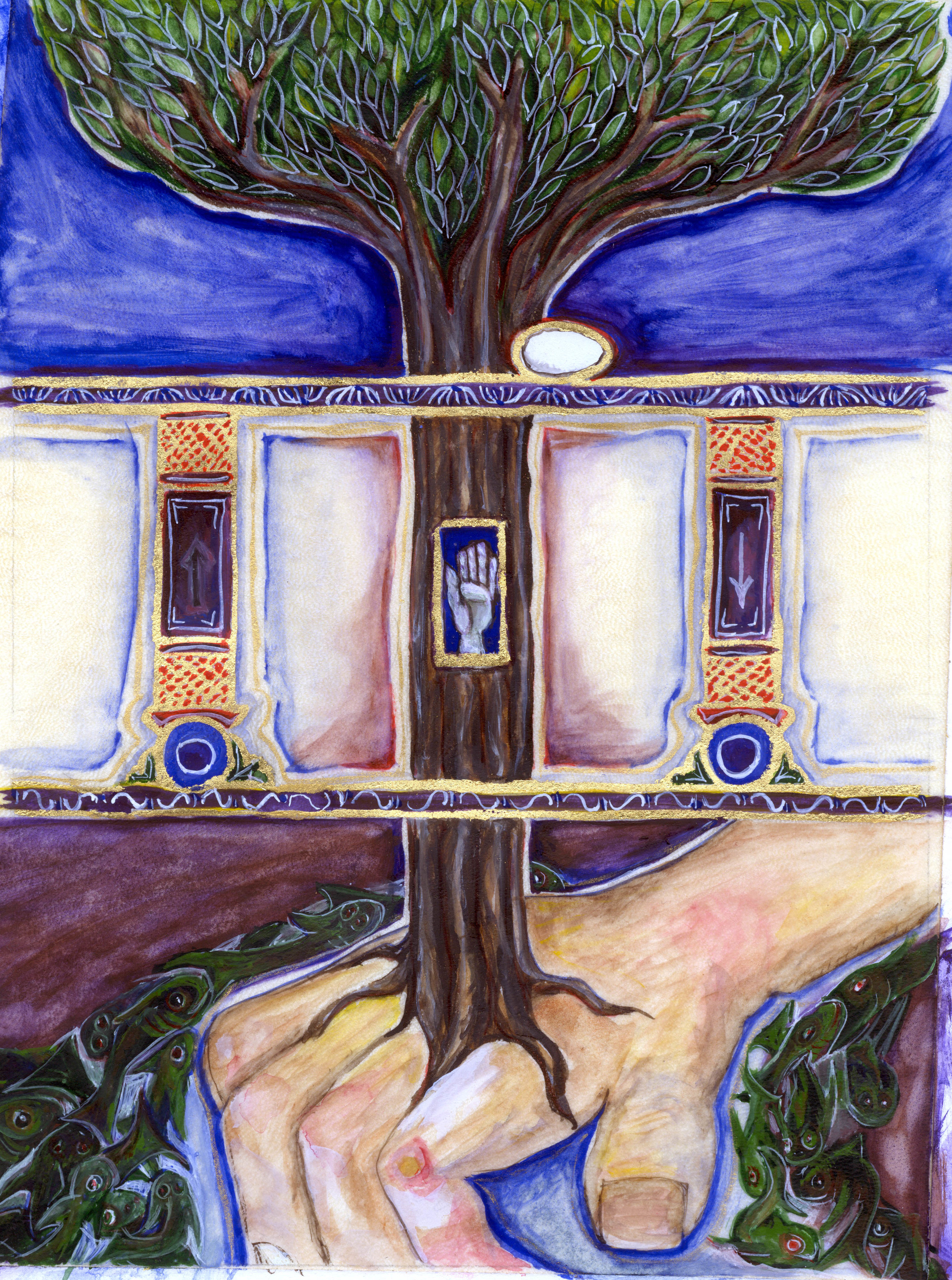
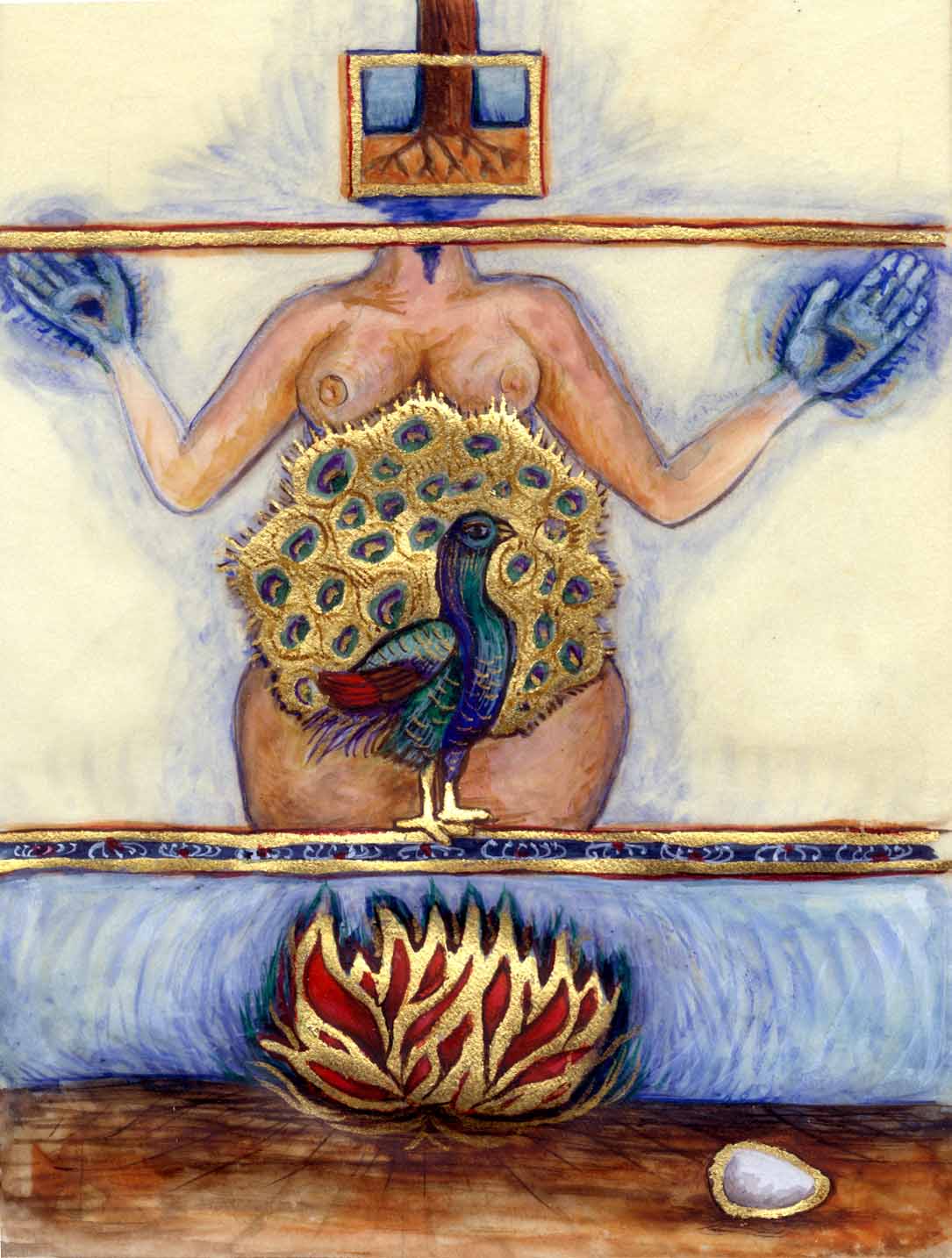

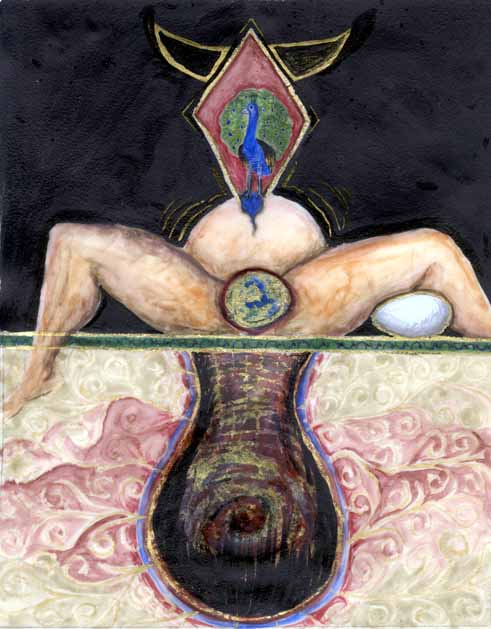
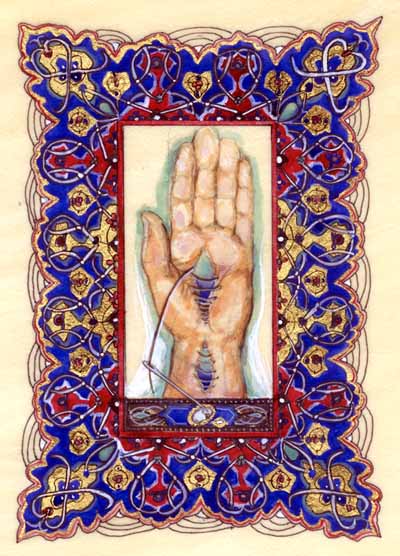
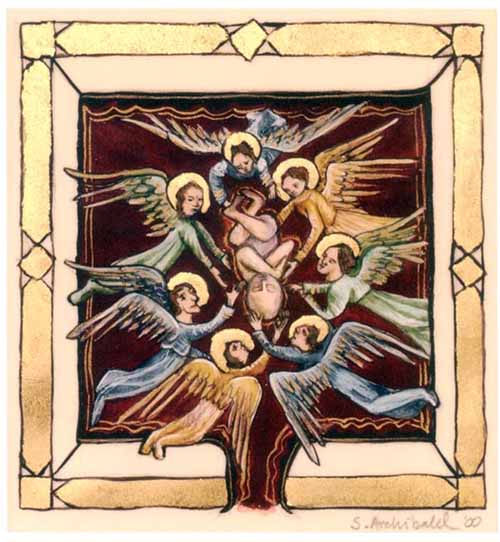
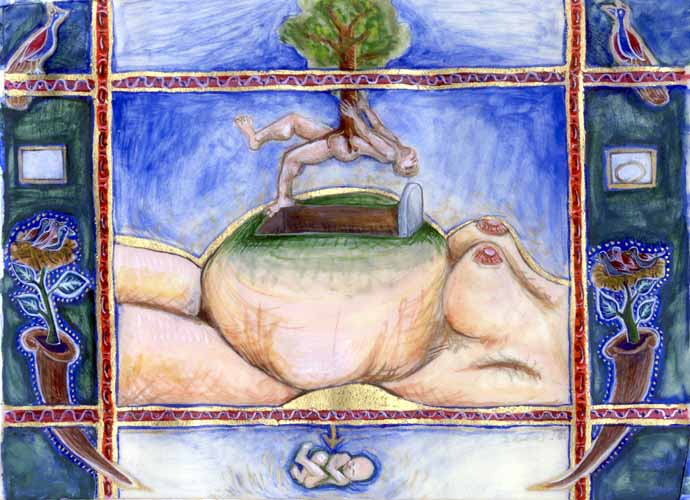
The Artist Illuminated, a Poem
Illuminations by Sybil Archibald, 22k gold leaf and handmade paints on animal skin parchment
Over at Abbey of the Arts, Christine is holding a poetry party. She writes:
I invite you this week to write a poem about your own invitation to enter the refiner’s fire – in alchemy lead is transformed into gold through heat and this becomes a metaphor for the human soul. What is the lead within you ready to be transformed into something treasured?
I am not normally a poet but this topic is near and dear to my heart, so I was inspired. Over the years, I've made a deep study of early alchemists and their influence on medieval art techniques. The process of manuscript illumination is deeply sacred and transformative. My early embrace of these techniques allowed me to see that making art, regardless of medium, is a spiritual practice. Though I use many different mediums now, within me the spiritual crack opened by illumination continues to expand with Light.For more on the technique and meaning of illumination, see my posts Finding the Sacred in Contemporary Art and Lapis & Gold.
The Artist Illuminated
Parchment
I trace the lines of God
on this dead skin-a calf once, a self
prepared to be reborn.Gilding
The red clay of Adam
laying lifeless upon skin,
desiring yet empty.Deep within
I find it-Divine breath,
hot, filled with life.
Exhaling,I wake the glue which binds
body to soul,
giving form to life.
The once rough clay
is now perfected
by a blanket of gold.
With a flash the gilded clay rises up,
a wild horse running free,
as the newly golden surface
reflects living Light
back to Its
SourceMaking Paint
I crush azure blue from a stone like so many grapes
All the while
emptying
my frail body of care,
surrendering concern.
Bleeding madder root in a bubbling pot,
heating iron over a fire to red.
Finding within
this lifeless squid,
its precious gift:
warm and brown
sepia stains my palms.The Artist
Thus paint is made,
and my own skin emptied,
a self once,
prepared to be reborn.
Here in this moment I stand
an emptied vessel.
I dip my brush
and disappear.
I am the the glove
for the fiery blue Hand of the Artist
which destroys as it creates.
I have been consumed
In tender, burning flame
a shell of my former self
all ashes, all dust
which I collect and slowly
begin to grind into paint.
-Sybil Archibald
Lapis & Gold
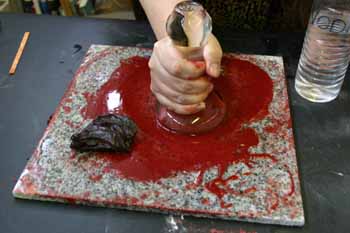

I just updated the website for my book Lapis & Gold: Unlocking the Secrets of Medieval Painters and Illuminators. It's an in depth look into medieval art technique and sacred and spiritual art practices. I hope it will help contemporary artists reclaim the power we’ve lost by relying on industrialized art supplies that pollute our environment and lack longevity. I also hope it will add to the dialogue about art as a spiritual practice. My writing partner, Karen Gorst, is a technical genius. There is so much in this book that has never been put to paper before. I’m really excited about it.I first became interested in illumination during college when I studied at the School of the Sacred Arts at the same time as I was immersed in studying medieval mystics at NYU. It seemed like the perfect art form to me, a marriage of the mystical and material. It is through illumination that I first began to understand the sacred and healing nature of making art. For many years, I strictly adhered to illumination technique:
The Binding of Isaac (Click image for larger view)
Now I just incorporate the techniques. I still make my own art supplies where I can but not always and I often work on paper instead of parchment. My work, however, is still true to the core values of the illumination technique: trust in process, trust in materials, and connection to the Divine. As Above, so below; the artist imitates the Divine Artist.I haven’t written much about my book here because I’ve been on an unplanned, life-enforced break. It had to be set it aside to help my husband close down his business in 2006 and then I had my heart episode/awakening and then our big move which caused my life to unravel into the chaos from which new things are built. I have, however, talked about many of the same themes of spirituality and have touched on technique in a few posts (see Finding the Sacred in Contemporary Art).I hope Lapis & Gold will appeal to a wide range of people. It has information for artists, art historians, spiritual seekers, conservators, medievalists and students of religion. Each chapter has technical information, ancient recipes tested and refined for contemporary use, history, and spirituality. (Click the links for chapter table of contents).
Supports: Paper and Parchment
Ink CalligraphyGilding
Pigments and Pigment Making
The Pigment Almanac (A reference guide to pigments)
PaintmakingProjects
A list of appendices
Here a sample of the types of information you will find in different chapters: the pigment chapter has detailed recipes, lightfastness & pigment interaction testing, and an in depth look at the alchemists who developed these recipes, their spiritual belief systems and how those believes manifest as you actually make each recipe; the calligraphy chapter has, among other things, directions for 3 writing styles, calligraphy as meditation, letter mysticism is the Christian, Judaic & Islamic traditions and the analysis of a medieval page to understand layout.So now finally the time is right to begin again on the journey that is my book. The writing in finished. Lapis & Gold has ripened* on the vine & is waiting for a hungry publisher to come and pluck it. Any advice, contacts, or help you could offer would be greatly appreciated!Thank you and bless you! Sybil* Upon rereading this, I was amused to find that I had unconsciously used the same metaphor as medieval alchemists who sometimes referred to the metals in their chemical reactions as ripening.
Filling the Vacuum a Little... Bringing Earth to Healing
Pieces from The Alchemist series, 22k Gold Leaf and handmade paints on sheep skin parchment
So today I’m allowed to lift my arm for the first time in a week. I still have to wait to lift it above my shoulder, but this is a happy day nonetheless! I also feel new energy and purpose.
Yesterday I spoke about holding the space open for the Divine to enter. It’s interesting, more happens when I wait and things that were unclear become clear. My family & I have thought for sometime of being away for part of the winter. Nothing was coming together so I sat back and waited. Now something wonderful has entered into that open space. It is a one month trip to sunny St. Thomas which I am going to use as an artist's retreat. I’ll be packing a small bag of clothes, a large trunk of art supplies and my laptop.Where I live just outside of New York City, I often feel disconnected from nature. Illness works on many levels it is most definitely spiritual direction on a personal level. But I have often wondered if it is something more too. Our bodies are the Earth. Creation stories from many peoples Apache , China, Aboriginal , African and of course the biblical story of Adam to name a few describe humanity as being created out of Earth. I have always felt that on some level my illness reflects the illness and decay of our planet. I firmly believe in the alchemical principle “As above, so below”. If we are pale reflections, echoes of our Creator, as physical creatures we must also be the echo of creation itself. Our blatant disregard for our own flesh must be on some level both manifestation and cause of the current plight of our dear planet.So I will take my time in the lush tropical greenery of St. Thomas to enter into the act of creation through my art and writing, but also to envelope my body in its physical source, nature. Like a child estranged from its parent, my body will find healing in the Earth’s loving arms.I have learned that I cannot control the illness in my body, greater forces than I can understand have plans for me for which I gladly wait. But I take heart. I believe physical healing is possible. I have always believed it and will continue my belief whether or not physical healing becomes part of my own path. What small steps I can take like resting, using my energy wisely, eating well or nurturing myself do have an effect. I must treat myself as if I were my own garden and this in turn must effect the Earth. My flesh is the land, it is Earth and the two cannot be separated except as an illusion in the human mind. My flesh is but a small grain of sand, but as I have said before, sand does have a way of piling up. The small ways in which we heal ourselves will begin the process of healing our planet.
Hail Mary enter my hands
Full of Grace
- fill me
Blessed art thou among women
-flesh joined with spirit, Earthoh endless Divine Womb
Blessed is the fruit of thy womb Jesus
-perfected jewel of creation present in every moment
Holy Mary mother of God
-ancient well, connect me to Your eternal stream
Pray for us sinners now
-let us heal the connection that has been sundered
and at the time
-circle upon circle
of our death.
-bring us lasting rebirth: flesh at with one spirit
-Sybil Archibald
Healing the Earth: The Calling of the Spiritual Artist?



Yesterday I spoke at length about the importance of a spiritual artist merging the physical and spiritual worlds in the act of creation. All art springs from the fecund stream of Divine creativity. I also spoke of the sacred principle “as above, so below.” This principle basically means that everything is an echo of the Divine.In the figure of Jesus, God as revealed many things, not the least that Divinity and physicality can be merged. Whether you believe in Jesus or not, the symbol is a potent one. I am not suggesting that an artist can bring full Divinity into their work, but I am suggesting that Jesus is the macrocosm and art is the paler, yet important, microcosm, the echo for integrating the physical & spiritual.This is why the Earth becomes so important. As long as we fool ourselves into thinking that anything we do is separate from the Earth, was cannot bring God here. If artists see the ideas in their work as more important than their physical execution, God is lost. This is why, in my opinion conceptual art fails so radically.In our society we have forgotten that everything we use is a fruit of the Earth. Perhaps it is easy to grasp that eggs come from chickens, but what of paint in tubes, plastic boots, or children’s toys? Let’s stay with the artist. How many artists know the source of their own paint? Does anyone realize that watercolor paint sticks to the page because of tree sap or that true ultramarine blue come from crushed stones? (More on this here.)
An artist must fully accept and embrace physicality. This is almost an impossibly hard task because by doing so we become confronted with the brokenness of our planet. To bring God into physicality through the act of creation is an act of healing. It is no more or less significant than any act of healing. It is only our egos which put a value judgment on it: “It’s only a painting, what can it possibly matter?” Each piece of art is but a grain of healed sand, but sand can pile up as anyone who lives near the beach can tell you. An artist must be content to labor at thier Divinely given task. To be an agent of healing requires nothing less than complete abandonment of self will and trust in the Divine steam of creativity which flows through us. As artists, we are called to heal the Earth.My next post will be about how some mystics view of the earth and healing. In the meantime checkout these amazing posts on Earth & Spirituality:
Gartenfische (of course!)
Sound and Silence(This starts out about Halloween, but keep reading, it’s worth it)
Art & The Physical
Making art is a physical act with physical outcomes. The crux of the problem is how to join the physical and spiritual worlds. How do we bring the sacred into physical form and why?I am deeply influenced by the ideas of early alchemists who sought to purify matter. Most people have heard of how alchemists looked for the philosopher’s stone, an elixir, which would transform base impure metals such as lead into gold. They described their quest as perfecting or healing matter. Gold, the purest metal, a symbol of the Divine on earth was not the true goal of an alchemist. Alchemists believed in the sacred principle “as above, so below” as written in the Emerald Tablet. As the alchemist purified matter externally, they believed they were making corresponding internal changes to the own souls. Their true goal was spiritual perfection & union with God.The same principle is at work when an artist creates. Artwork manifests the spiritual changes occurring within the artist as they create. All creativity is ignited from the same flame, tapped from the same eternal well. By creating, artists contact & connect with their source and that fundamentally changes them. Why do you think so many artists turn to drink and flirt with madness? This connection with our source is awesome and can be overpowering and painful. Artists don’t need pain and suffering to create, but most of us are so closed off from our Divine source that when we access it, the pain of our separation crashes down on us in a crushing blow. It’s not the pain an artist needs to create, it’s the pain that comes with the act of creation.However, if an artist or mystic continues to seek God eventually they become tempered like a sword in the fire and can bear more closeness with less pain. When the artist learns to allow the fecund stream of Divine creativity to flow through them with out expectation or control, the artwork which is created resonates with God. This artwork becomes a pivoting point from this world to the next. But the goal is not to escape the physical and return to God, it is to join the two worlds as one. Art can provide a powerful experience of the Divine in a way few other things can.Sister Wendy has a really interesting passage in her book The Mystical Now: Art and the Sacred (Thanks John for pointing it out to me!):
GK Chesterton, mourning our state as fallen creatures, ego-lovers…explained: ”We have forgotten who we and what we are.” And art, he said, ”makes us remember that we have forgotten.” This is painful. It is also our best means apart from direct contact with God, of rediscovering that interior integrity. All great art, being spiritual, both grieves over and celebrates “what we are.” It needs no religious iconography for this…(p. 9)
She goes on to say that this is why “so many people unconsciously fear and resist art.” It is not the fear of art, it is the fear of God.I think it is clear from what I have said, that artists have a responsibility for the physical nature of what they create. Elsewhere, I’ve discussed the artist’s responsibility to the Light, to choose to be a vessel for light and good in this world. But this is slightly different. Artists also have a responsibility to the material world. As the alchemists did with metals, the artist purifies matter in the act of creation. Our responsibility is nothing less than to be active participants in healing the earth. My next post will clarify this in further.
Early Alchemists & the Spiritual Artist

Image: The mind of the microcosm from Robert Fludd Utriusque cosmi... historia, 1619
Following up on yesterday’s post about the sacred in contemporary art, I’d like to say a few words about alchemy. Ancient alchemists sought to turn base metals such as lead into gold. But many people fail to realize that gold was not the main goal of their endeavors. A key tenet of alchemy is found in this phrase from the Emerald Tablet: “As above, so below”: the microcosm reflects the Macrocosm. By effecting change on a physical level, alchemists believed they were creating a corresponding change in their souls. The search to transmute or “perfect” matter into gold was really the search to perfect their own spiritual natures.
The alchemist and the spiritual artist are kindred spirits. We work through matter, whether it be clay, paint, or video, just as the alchemists did. We both change and transform matter, perfect it, to align with our visions. And finally, like the alchemists, it is our engagement with the material world that grounds us and gives us the ability to enter deeper into the Divine and be transformed ourselves.For more on alchemy check out the Alchemy Website. It is an amazing resource!
Ouroboros
Yesterday I had a doctor’s appointment. It seemed like a normal appointment until, in the middle of a technical discussion, my doctor described one of my symptoms as a serpent with its tail in its mouth. I was floored. To hear an allopathic doctor refer to an ancient mystical symbol was completely unexpected.
The symbol of a serpent with its tail in its mouth, or Ouroboros (Auroboros/Uroboros), dates back to 1,600 BCE in Ancient Egypt but has been used at many times and in many cultures. I am most familiar with it from from medieval & alchemical manuscripts. (For an interesting discussion by contemporary alchemists click here.)
The Ouroboros contains so many meanings: the circular, cyclical nature of time, regeneration and rebirth, and all is one to name a few. My doctor used this symbol to describe a situation that once started, feeds on itself. He described it like a storm, once it starts it continues going round and round much like a tornado or “a snake with its tail in its month”.
If the Ouroboros contains the meaning that all ‘existence’ is one, one of its meanings must be Divine Intelligence. According to Plotinus, the One (emptiness, non-existence, & the womb of God) emanates Divine Intelligence, which is primal existence, pure Being. The Intelligence then emanates more forms, but It is the first division with the Godhead. Before it there is Nothingness, non-being. That the Ouroboros represents the oneness of “all existence” means it must necessarily represent the One’s first emanation: the Intelligence. Divine Intelligence or Reason cannot be comprehended by man. It seems, much like a tornado, to be a state of complete chaos. The moments of chaos in our lives, therefore, are moments when we come closest to knowing God’s existence.
I have always understood that my physical ailments are divinely sent. They have been my greatest teacher, my Guru so to speak, my guide into the hidden mysteries of life. But, sometimes this can be forgotten in the daily grind of life. Yesterday, in a phrase, the symbol of the Ouroboros reminded me of the gift I have been given: the closeness of my embrace with the Divine.
Update: As with most symbols, this one works on many levels. On one level it represents the Intelligence, but on another level it can represent the One as well. It is the union of opposites, the end (the tail) and the beginning (the head) at the same time. Its circularity recalls the Womb of God, the nothingness, precipitated by holding two opposites as one, which births forth the Universe. During the medieval period they also spoke of this state as the squared circle.


